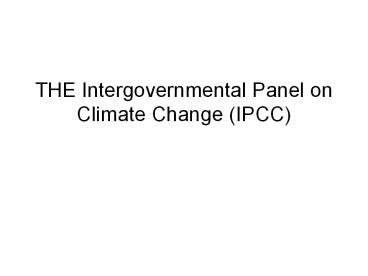THE Intergovernmental Panel on Climate Change (IPCC) PowerPoint PPT Presentation
1 / 19
Title: THE Intergovernmental Panel on Climate Change (IPCC)
1
THE Intergovernmental Panel on Climate Change
(IPCC)
2
Human activities have already begun to affect
global climate. Scientists have learned much
about climate and how it responds to human
activities such as emissions of carbon dioxide
and other greenhouse gases. Nevertheless,
great uncertainty remains.
3
Climate change challenges policymakers. Some
argue that it poses a risk of such serious damage
that the lack of full scientific certainty should
not be used as an excuse to postpone
action. Others regard the risk as manageable and
not worth a major shift in the investment of
financial and human resources.
4
Somehow, policymakers must sort through the
evidence, weigh the costs and benefits, evaluate
the risks, and decide on action. Science has a
role to play in informing wise policy. Because
the stakes are so high and the system so complex,
policymakers cannot rely on on any single expert
viewpoint.
5
Policymakers need an objective source of the most
widely accepted scientific information about
climate change, its effects, and possible
response options. The IPCC was established in
1988 to meet this need.
6
The World Meteorological Organization (WMO) and
the United Nations Environment Programme (UNEP)
jointly established the IPCC. It is important to
understand that the IPCC is both governmental and
scientific.
7
Establishing the IPCC
- 1979 First World Climate Conference,
WMO. - 1985 Assessment of the Role of Carbon Dioxide and
of Other Greenhouse Gases in Climate Variations
and Associated Impacts (UNEP, WMO, ICSU).
Conclusion we are headed to new climate extremes
in the first half of the 21st C. - 1988 IPCC established at WMO with UNEP governance.
8
Original IPCC Charge (1988)
- Science of climate and climatic change
- Social and economic impacts
- Possible response strategies
- International legal instruments
- International convention on climate
9
IPCC does not conduct new research. Its mandate
is to assess, on a comprehensive, objective, open
and transparent basis, the available scientific
information in peer-reviewed literature. IPCC
reports are policy-relevant but not
policy-prescriptive or policy-driven.
10
The IPCC has produced four major Assessment
Reports (1990, 1995, 2001, 2007). Each includes
Summaries for Policymakers, written so as to be
comprehensible to the non-specialist. These are
published in all six UN languages.
11
The 1990 IPCC First Assessment Report confirmed
the scientific basis for concern about climate
change. It helped persuade governments to adopt
the UN Framework Convention on Climate Change,
signed at the Earth Summit in Rio de Janeiro
(1992).
12
The 1995 IPCC Second Assessment Report
contributed crucially to the negotiations that
led to the adoption of the Kyoto Protocol in
1997. The Kyoto Protocol, which would restrict
emissions of greenhouse gases, has not yet come
into force, mainly because of opposition from the
United States.
13
IPCC Summary Statements
- FAR, 1990 The unequivocal detection of the
enhanced greenhouse effect is not likely for a
decade or more. - SAR, 1995 The balance of evidence suggests a
discernible human influence on global climate. - TAR, 2001 Most of the observed warming over the
last 50 years is likely to have been due to the
increase in greenhouse gas concentrations. - AR4, 2007 Most of the observed increase in
globally averaged temperatures since the mid-20th
century is very likely due to the observed
increase in anthropogenic greenhouse gas
concentrations. - AR5, 2011 AGW very, very likely? No, Aiming
for more applied science, what should we do about
climate change?
14
Increasing Resolution FAR 1990 SAR 1995 TAR
2001 AR4 2007
15
The World In Global Climate Models
16
AR4 WG2 SPM
- The impacts of climate change are, with high
confidence (80), expected to be most significant
when and where they occur in the context of
multiple stresses from other sources such as
poverty, unequal access to resources, food
insecurity, and environmental degradation. The
intensities of these interactions vary from place
to place and over time along specific development
pathways. - Medium confidence (50) global estimates of the
number of people adversely affected by climate
change by 2080 water scarcity 1-3 billion,
hunger 200-600 million, coastal flooding 2-7
million.
17
AR4 WG2 fresh water resources
18
- What Students (and Professors) Can Do
- Climate change is real and serious. Its not a
hoax. It wont go away. It needs thoughtful
action. - Everybody can play a role. Be better informed.
Keep this issue prominent. The USA can lead. - Scientific illiteracy helps spread
misinformation. Educate kids ( corporations
politicians too). - Get comfortable with sensitive issues.
Population is a driver. Personal values matter.
Think.
19
www.ipcc.ch

